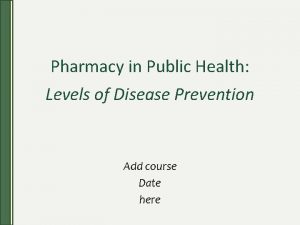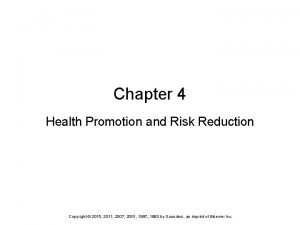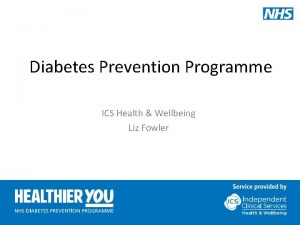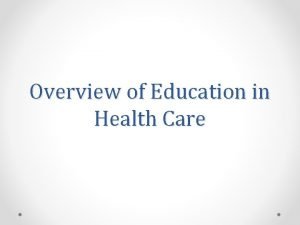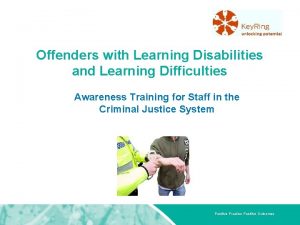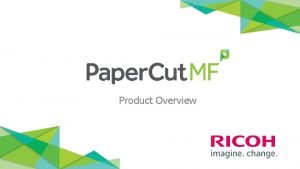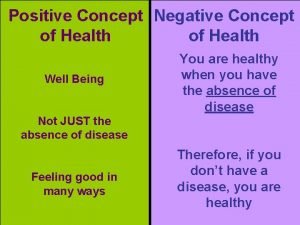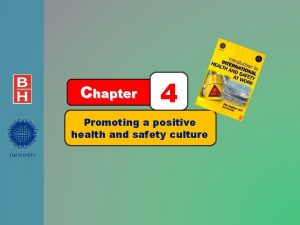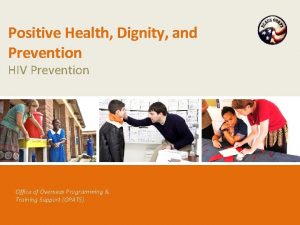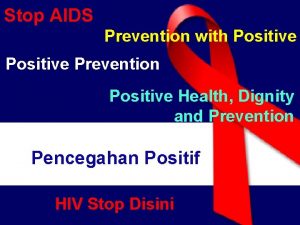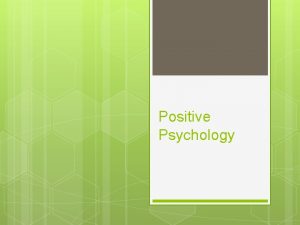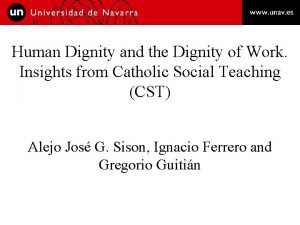POSITIVE HEALTH DIGNITY AND PREVENTION INTRODUCTION AND OVERVIEW














- Slides: 14

POSITIVE HEALTH, DIGNITY, AND PREVENTION INTRODUCTION AND OVERVIEW MODULE 1 The Framework of Positive Health, Dignity, and Prevention

Introduction A strategy that encompasses the three main areas on which the improvement of the lives of people living with HIV depends. The three main areas are: 1. Positive health 2. Positive dignity 3. Positive prevention

Overview Positive Health, Dignity, and Prevention (PHDP) is An approach to ‘HIV treatment and prevention with people living with HIV’ based in human rights and led by people living with HIV. Primary Goal: Support people living with HIV to achieve health and a stronger sense of well-being and self-worth. Corollary Goal: Benefit public health (greater control of the HIV epidemic, reduced HIV incidence, less burden on the health system). Can be downloaded at www. gnpplus. net

How was it developed? Positive Health, Dignity, and Prevention: A Policy Framework Finalised in March 2011 Result of a three-year collective, coordinated process Led by and for Global Network of People Living with HIV (GNP+) Developed with networks of people living with HIV around the world Included input from UNAIDS, donor agencies, public-sector stakeholders ▪ Rolled-out to put into practice Updated PHDP (2017) Reflects new global evidence and updated country guidelines Updated with people living with HIV networks and key stakeholders in Jamaica Core modules adapted for health facility and auxiliary worker training

Why it was developed? To provide a platform and tools for the greater involvement of people living with HIV in the personal and national response to HIV. To equip people living with HIV with essential information and skills for living emotionally- and physically-healthy lives To provide (clinical and non-clinical) support staff insights on how to best support people living with HIV.

Why it was developed? (cont’) To move beyond ‘positive prevention’ and ‘prevention with positives. ’ To holistically: Affirm the right to health and well-being, including the importance of addressing treatment and prevention simultaneously. Respond to legal, policy, and other structural barriers to health and dignity. Nurture and enhance leadership of people living with HIV across all areas and levels of programming and policy.

Positive Health, Dignity, and Prevention (PHPD) Global framework includes 1. Core values 2. Guiding principles of involvement 3. Programming and policy objectives 4. Nine key areas to strengthen programming . . . plus examples of promising practices

Global Framework – 1. Core Values Positive Health, Dignity, and Prevention seeks to: • Improve and maintain the health and well-being of people living with HIV. • Promote holistic health and wellness. • Address psychosocial, economic, educational, and socio-cultural vulnerabilities, as well as gender and sexuality. • Respect and be tailored to specific contexts and the diversity of people living with HIV. • Help to ensure a supportive and protective legal and policy environment.

Global Framework – 2. Principles of Involvement Positive Health, Dignity, and Prevention affirms that we need a collective response, with the full engagement of people living with HIV: “It is not who you are but what you do. ” We are all at risk. “Having HIV has not made us less than human beings. ” A human rights approach is the foundation of Positive Health, Dignity, and Prevention. “All of Jamaica is responsible for the prevention of HIV. ” It is a shared responsibility. “We deserve a family too. ” Sexual and reproductive health and rights must be recognised and exercised by everyone, regardless of HIV status.

Global Framework – 3. Programming and Policy Objectives Positive Health, Dignity, and Prevention aims to: 1. Expand policy and programming approaches that support people living with HIV to make informed choices and live free of stigma, discrimination, and gender-based violence. 2. Scale-up and expand community-owned HIV counselling, testing, care, support, treatment, and prevention programmes that include sexual and reproductive health and rights. 3. Expand literacy programmes related to care, treatment, and human rights. 4. Promote shared responsibility for HIV prevention. 5. Invest in the social capital of organisations/networks of people living with HIV and key populations.

Global Framework – 9 Key Programming Components Nine key components are needed to put Positive Health, Dignity, and Prevention into practice: Treatment literacy Empowerment Gender equality Human rights Sexual and reproductive rights Health promotion and access Preventing new infections Social and economic support Meaningful involvement of people living with HIV in measuring impact

Barriers and Challenges: Stigma and Criminalisation Do you still hear (and see) these messages? “HIV-positive people should not have sex. ” “HIV-positive people should use condoms or go to prison. ” “HIV-positive women should not have children. ”

What Works Do you see (and hear) messages like this? What’s helped to move towards positive health, dignity, and prevention? What’s still needed?

Thank You This presentation was collaboratively developed by leaders of the people living with HIV community (Pilot Cohort of the GIPA Capacity Building Project, National HIV/STI Programme, and the Jamaican Network of Seroposities or JNPlus), with support from the Health Policy Project (HPP)/Jamaica. Updates were provided by Health Policy Plus (HPP’s follow-on project), in close collaboration with people living with HIV and other key stakeholders in Jamaica.
 Primary prevention secondary prevention tertiary prevention
Primary prevention secondary prevention tertiary prevention Health promotion and levels of disease prevention
Health promotion and levels of disease prevention Health promotion and levels of disease prevention
Health promotion and levels of disease prevention Ics health and wellbeing
Ics health and wellbeing Multicullar
Multicullar Example of nursing process
Example of nursing process Agar
Agar What's 8 + 5
What's 8 + 5 Positive practice positive outcomes
Positive practice positive outcomes Papercut job tickerting print management
Papercut job tickerting print management Introduction product overview
Introduction product overview Introduction product overview
Introduction product overview Introduction product overview
Introduction product overview Positive concept
Positive concept Promoting a positive health and safety culture
Promoting a positive health and safety culture

